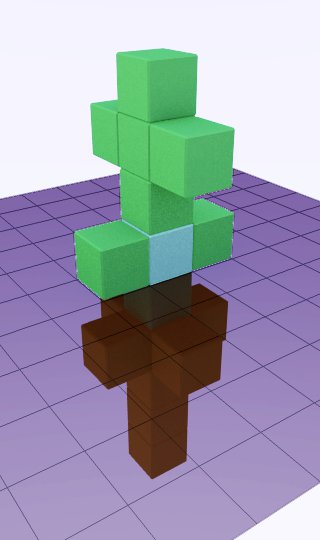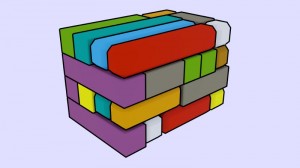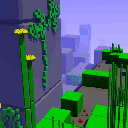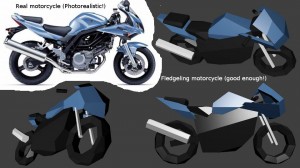Over the years I’ve written quite a few python utilities. Most of them are really short, and too specific to be useful to others. Those that aren’t are so long that they don’t feel elegant enough to share.
And then, between these two extremes, are the gems that I find myself coming back to time and again. I thought I’d share these with you. Keep in mind that all of these are covered by the Paul Spooner “IP is Wicked Nonsense” license, and you are encouraged to evaluate them on their own merits as distinct from their history. If you insist that the origins of ideas are important, then go pledge your support to my efforts.
TextOddifier.py is a text manipulation script to convert letters in UTF-8 to fairly similar looking letters. It makes text that looks like this ḽӧœĸ ŀįҟԙ ҭԡ༑ṩ ѩʼnᵴťӕаԂ. You can find the source below, or through the link at the start of the description.
1 2 3 4 5 6 7 8 9 10 11 12 13 14 15 16 17 18 19 20 21 22 23 24 25 26 27 28 29 30 31 32 33 34 35 36 37 38 39 40 41 42 43 44 45 46 47 48 | from random import choice
SLD = { 'A':'ĀĂĄАѦѨӐӒӔḀẲⰡ⍲ᗗ','a':'āăąаѧѩӑӓӕḁẳ⎀',
'B':'ВѢҌ฿ḂḄḆᙗᙫ','b':'ЉЊБЪЬъыьѣҍḃḅḇᒀᖲ',
'C':'ĆĊČСҪℂ℃','c':'ćĉċčсҫ',
'D':'ĎĐḊḌḎḐḒ⫐⫒ᗫᗤ','d':'ďđԀԁԂԃḓḑḏḍḋᑽᖱ',
'E':'ĒĔĖĘĚŒЀЁЄЕѤӔӖԘ⋵⋶ᕮ','e':'ēĕėęěœеѐёѥӕӗԙ',
'F':'ҒӺḞ℉ᖴ','f':'ſғӻẛẜẝḟ',
'G':'ĜĞĠĢԌḠ','g':'ĝğġģḡ',
'H':'ĤĦЊНҔҢҤӇӉԊԢԨԪ','h':'ĥħЂЋђћҕңҥӈӊԡԦԧℎℏ',
'I':'ĨĪĬİIJІЇЮѤѨӀ','i':'ĩīĭįıijіїѩ༐༑',
'J':'IJĴЈЉӇԈԒԔᒏ','j':'ijĵЛјӈԓԕ',
'K':'ĶЌЖКҖҚҜҞҠӃԖԞԪ','k':'ķĸкҗқҝҟҡӄԗԟ',
'L':'ĹĻĽĿŁḶḸḺḼᒺ','l':'ĺļľŀłӏḷḹḻḽ',
'M':'МӍᴍḾṀṂ','m':'ӎᵚᵯmṃṁḿ',
'N':'ŃŅŇŊЍИЙҊӢӤ','n':'ńņňʼnŋҋᵰ',
'O':'ŌŎŐŒОЮѺӦ⥀⥁','o':'ōŏőœбоѻӧ',
'P':'РҎԖⰒⰐᑬᑭᑮᑶᑸ','p':'рҏԗᵱⱀᖰ',
'Q':'ҀԚⰢ','q':'ҁԛⱉᖳ',
'R':'ŔŖŘЯԄԆԖԘ℞ᖇ','r':'ŕŗřѓг',
'S':'ŚŜŞŠЅṦṨᔡ','s':'śŝşšѕᵴṩṧṥ',
'T':'ŢŤŦЂЃЋГТѢѢҬԎ','t':'ţťŧҭԏ',
'U':'ŨŪŬŮŰŲ⩂⩁⋃ᙈᙀ','u':'ũūŭůűų',
'V':'ѴѶṼṾⰜ⩢⩣⩛⩝⍱⋁ᐻ','v':'ѵѷṿṽⱌ⩡',
'W':'ŴѠѼѾԜ','w':'ŵѡѽѿԝ⍹',
'X':'ЖХҖӁӜӼӾԔ','x':'жхҗӂӝӽӿԕẋ',
'Y':'ŶŸЎУҮӮӰӲ','y':'ŷуўӯӱӳ',
'Z':'ŹŻŽᤏᤁ','z':'źżžᙇ',
'.':'.․⁝⁞',
'?':'?‽⁇⁈',
}
def oddify(text):
result = ""
for i in text:
try: result += choice(SLD[i])
except: result += i
return result
s = input("enter the text you want to oddify: ")
print(oddify(s))
input("Press enter when done:")
|
BaseConverter_py.py is a number base converter that we collaborated on to convert numbers to and from arbitrary radix. The neat thing about it is it works on floating point numbers as well as integers. The example (and test case) is 135.5 converted to base 12 is B3.6. Going the other way around, S4 in base 35 is 984 in decimal! You can find the source below, or through the link at the start of the description.
1 2 3 4 5 6 7 8 9 10 11 12 13 14 15 16 17 18 19 20 21 22 23 24 25 26 27 28 29 30 31 32 33 34 35 36 37 38 39 40 41 42 43 44 45 46 47 48 49 50 51 52 53 54 55 56 57 58 59 60 61 62 63 64 65 66 67 68 69 70 71 72 73 74 75 76 77 78 79 80 81 82 83 84 85 86 87 88 89 90 91 92 93 94 95 96 | BASE = 12
PREC = 8
GLYPHS = {}
VALUES = {}
def compute_glyphs():
global GLYPHS, VALUES
GLYPHS = {}
VALUES = {}
for i in range(BASE):
if i < 10: GLYPHS[i] = str(i)
else: GLYPHS[i] = chr(i+55)
for i in range(len(GLYPHS)):
VALUES[GLYPHS[i]] = i
def rebase(num):
if len(GLYPHS) != BASE: compute_glyphs()
if num < 0:
sign = '-'
num = -num
else: sign = ''
whole = int(num)
frac = num - whole
whole_parts = []
frac_parts = []
prec = PREC
while prec > 0:
prec -= 1
frac *= BASE
part = int(frac)
frac -= part
if part == 0: break
frac_parts.append(GLYPHS[part])
while whole > 0:
mod = whole % BASE
whole = whole // BASE
whole_parts.append(GLYPHS[mod])
if len(whole_parts) == 0:
whole_parts.append(GLYPHS[0])
if len(frac_parts) == 0:
return sign + "".join(reversed(whole_parts))
return sign + "{}.{}".format("".join(reversed(whole_parts)),
"".join(frac_parts))
def debase(string):
if len(GLYPHS) != BASE: compute_glyphs()
if string[0] == '-':
negative = True
string = string[1:]
else: negative = False
try:
whole_parts, frac_parts = string.split(".")
except:
whole_parts = string
frac_parts = ''
whole = 0
for idx in range(len(whole_parts)):
whole += VALUES[whole_parts[idx]]
if idx < len(whole_parts) - 1:
whole *= BASE
frac = 0
max_idx = len(frac_parts) - 1
for idx in range(len(frac_parts)):
part = frac_parts[max_idx - idx]
frac += VALUES[part] / BASE
if idx < max_idx:
frac /= BASE
result = whole + round(frac,PREC)
if negative: return -result
return result
TestConvert = 135.5
TestDozenal = rebase(TestConvert)
print("{} converted to base {} is".format(TestConvert,BASE), TestDozenal)
ConvertedBack = debase(TestDozenal)
print("{} in base {} is".format(TestDozenal,BASE), ConvertedBack, "in decimal")
if TestConvert == ConvertedBack: print("success!")
else: print("Something went wrong")
print("Assign BASE to set the number base,\nand PREC to set the precision.\nCall rebase() to convert,\nand debase() to convert back to decimal.")
|
Renamer.py Is a short program I wrote to do simple renaming operations on files. It only operates on the files in the folder, so it’s pretty easy to target. I include it here mostly as a syntax reminder. Change “rename” to “renames” to create directories (folders), which are separated by a forward slash.
1 2 3 4 5 6 7 8 9 10 11 12 | from os import rename, listdir
thesefiles = listdir()
target = "Prefix"
tlen = len(target)
for f in thesefiles:
if f[:tlen] == target:
n = f
n = n[:tlen] + '_' + n[tlen:]
rename(f, n)
print(n)
|
mcm_page.py is kind of an odd one. I really like the McMaster-Carr website, and enjoy browsing their catalog for inspiration. Time was when the catalog was paper that you could turn to a random page and peruse it. However, the online catalog is so efficient at delivering what you want that this becomes difficult. I’d also like to ensure that I don’t keep seeing the same page over again, at least until I’ve gone through the whole catalog. This script does all of that, opening a random page of the catalog when you start it, and allowing a save file listing all the pages you haven’t visited yet. Could be easily modified for other things… monte-carlo webcomic binges for example.
1 2 3 4 5 6 7 8 9 10 11 12 13 14 15 16 17 18 19 20 21 22 23 24 25 26 27 28 29 30 31 32 33 34 35 36 37 38 39 40 41 42 43 44 45 46 47 48 49 50 51 52 53 54 55 56 | from random import choice
import webbrowser
HIGHEST_PAGE_NUMBER = 4061
try:
f = open('mcm_page_numbers.txt','r')
maxpgraw = f.readline()
raw = f.readline()
f.close()
maxpg = int(maxpgraw)
rem_pgs = eval(raw)
if maxpg == HIGHEST_PAGE_NUMBER: pass
elif maxpg > HIGHEST_PAGE_NUMBER:
while len(rem_pgs)>0:
if rem_pgs[-1] > HIGHEST_PAGE_NUMBER: rem_pgs.pop()
else: break
elif maxpg < HIGHEST_PAGE_NUMBER:
for i in range(maxpg,HIGHEST_PAGE_NUMBER+1):
rem_pgs.append(i)
else: print("Something went terribly wrong")
except:
rem_pgs = &
inchoice = ""
print('{} pages left'.format(len(rem_pgs)))
print('Enter to bring up a McMaster page\n"s" to save, "sc" to save and close, "p" to print')
while len(rem_pgs) > 0:
printflag = False
if len(inchoice)!= 0:
inchoice = inchoice.lower()
initial = inchoice[0]
if initial == 's':
print("Saving")
f = open('mcm_page_numbers.txt','w')
f.write(str(HIGHEST_PAGE_NUMBER)+'\n')
f.write(str(rem_pgs))
f.close()
if inchoice == 'sc': break
else: print('{} pages left'.format(len(rem_pgs)))
inchoice = input('Saved :')
continue
elif initial == 'p':
print(rem_pgs)
inchoice = input('Those are the currently loaded indicies :')
continue
idx = choice(range(len(rem_pgs)))
chosen_page = rem_pgs.pop(idx)
inchoice = input('Page {} queued:'.format(chosen_page))
input("There are no more pages. Press return to close.")
|
NatoPhoneticAlphabet.py Is a dumb little thing that converts characters into their equivalent in the NATO Phonetic Alphabet. More of a fun toy than a useful tool.
1 2 3 4 5 6 7 8 9 10 11 12 13 14 15 16 17 18 19 20 21 22 23 24 25 26 27 28 29 30 31 32 33 34 35 36 37 38 39 40 41 42 43 44 | SLD = { 'A':'Alfa',
'B':'Bravo',
'C':'Charlie',
'D':'Delta',
'E':'Echo',
'F':'Foxtrot',
'G':'Golf',
'H':'Hotel',
'I':'India',
'J':'Juliet',
'K':'Kilo',
'L':'Lima',
'M':'Mike',
'N':'November',
'O':'Oscar',
'P':'Papa',
'Q':'Quebec',
'R':'Romeo',
'S':'Sierra',
'T':'Tango',
'U':'Uniform',
'V':'Victor',
'W':'Whiskey',
'X':'X-Ray',
'Y':'Yankee',
'Z':'Zulu',
'9':'9er',
'0':'Zero',
}
def phoneticize(text):
result = []
for i in text.upper():
try: result += [SLD[i]]
except: result += [i]
return " ".join(result)
while(True):
s = input("enter text: ")
print(phoneticize(s))
|
I have enjoyed playing with the Fantasy Genesis book for several years now, and at one point wrote this python script to cut out all the dice rolling.
1 2 3 4 5 6 7 8 9 10 11 12 13 14 15 16 17 18 19 20 21 22 23 24 25 26 27 28 29 30 31 32 33 34 35 36 37 38 39 40 41 42 43 44 45 46 47 48 49 50 51 52 53 54 55 56 57 58 59 60 61 62 63 64 65 66 67 68 69 70 71 72 73 74 75 76 77 78 79 80 81 82 83 84 85 86 87 88 89 90 91 92 93 94 95 96 97 98 99 100 101 102 103 104 105 106 107 108 109 110 111 112 113 114 115 116 117 118 119 120 121 122 123 124 125 126 127 128 129 130 131 132 133 134 135 136 137 138 139 140 141 142 143 144 145 146 147 148 149 150 151 152 153 154 155 156 157 158 159 160 161 162 163 164 165 166 167 168 169 170 171 172 173 174 175 176 177 178 179 180 181 182 183 184 185 186 187 188 189 190 191 192 193 194 195 196 197 198 199 200 201 202 203 204 205 206 207 208 209 210 211 212 213 214 215 216 217 218 219 220 221 222 223 224 225 226 227 228 229 230 231 232 233 234 235 236 237 238 239 240 241 242 243 244 245 246 247 248 249 250 251 252 253 254 255 256 257 258 259 260 261 262 263 264 265 266 267 268 269 270 271 272 273 274 275 276 277 278 279 280 281 282 283 284 285 286 287 288 289 290 291 292 293 294 295 296 297 298 299 300 301 302 303 304 | Anim_1_Sea_Life = ["Mollusk",
"Crab, Lobster",
"Squid, Mudskipper",
["Fish: Deep sea", "Fish: Fresh water"],
"Jellyfish",
[["Whale", "Killer Whale", "Narwhale"], "Dolphin", "Walrus", "Otter"],
["Shell: spiral", "Conch", "Shell: ribbed, clam"],
"Eel, Leech, Hagfish",
"Coral, Anemone",
"Shark, ray"]
Anim_2_Insect = ["Worm",
"Ant",
"Mosquito",
"Moth, Butterfly",
"Fly, dragonfly",
"Lotus, Mantis",
"Bee, Wasp",
"Caterpillar, Centipede, Milipede",
"Beetle, Scarab",
"Flea, Mite",
"Spider"]
Anim_3_Mammal = ["Sheep, cow",
"Mouse, Rabbit",
"Pig, Boar",
"Deer, Pronghorn",
"Ram, Bull, Buck",
"Elephant, Giraffe",
"Bat",
"Bear",
"Lupine: Wild Dog",
"Horse, Zeebra",
"Feline: Wild Cat",
"Primate"]
Anim_4_Reptile = ["Crocodile, Gila",
"Frog, Newt",
"Lizard, Snake",
"Turtle"]
Anim_5_Bird = ["Wild Fowl, Duck, Goose",
"Farm Fowl, Rooster",
"Seabird, Penguin, Gull",
"City bird: Raven, Sparrow",
"Tropical bird: Parrot, Heron",
"Bird of Prey: Hawk, Owl",
"Hummingbird"]
Vegi_1_Plant = ["Seaweed",
"Fern",
"Desert Cacti",
"Thick Leaf Plant, Jade",
"Flower: Domestic",
"Vine",
"Poppy",
"Grass, Dandelion",
"Bamboo",
"Flower: Wild",
"Carnivorous Plant"]
Vegi_2_Fruit_Vegi = ["Asparagus",
"Pinecone",
"Berry, Grapes",
"Ginger",
"Tree fruit (apple, orange)",
"Bean",
"Pumpkin, Gourd",
"Broccoli, Artichoke",
"Corn",
"Grain, Wheat",
"Pineapple"]
Vegi_3_Fungi = ["Moss",
"Slime Fungi: Ooze, Jelly",
"Lichen",
"Mushroom"]
Vegi_4_Tree = ["Willow",
"Birch",
"Maple, Oak",
"Banyan",
"Pine",
"Palm"]
Elem_1_Fire_Electric = ["Fire, Vapor",
"Electric Bolt",
"Ember, Hot Coal",
"Molten Lava"]
Elem_2_Liquid = ["Icicles",
"Fog, Vapor",
"Wave",
"Dew Drops",
"Ripple",
"Frost, Snow",
"Suds, Bubbles",
"Tar, Gum"]
Elem_3_Earth_Metal = ["Malachite",
"Mountain, Cliff Face",
"Brick, Cobblestone",
"Rust, Oxide",
"Cracked Clay",
"Stalactite, Stalagmite",
"Glass, Crystals",
"Powder, Sand",
"Slate, Shale",
"Cement, Sediment",
"Mercury, Chrome"]
Elem_4_Astral_Atmosphere = ["Moon Cycles",
"Starfield",
"Crater, Asteroid",
"Solar Flare",
"Galaxy form",
"Volcano",
"Planets, Saturn's Rings",
"Cloud, Cyclone, Turbulence"]
Tech_1_Transportation = ["Car, Truck, Bus",
"Aircraft",
"Rail, Train, Trolley",
"Cycle (motor or bi)",
"Sled, Ski",
"Boat, Ship",
"Spacecraft",
"Tank, Caterpillar Tread"]
Tech_2_Architecture = [["Ornament, Gargoyle", "Ornament, Pillar"],
"Bridge, Framework",
"Castle, Dome",
"Modern Skyscraper",
["Place of Worship", "Totem", "Cathedral", "Temple"],
["Doorway, Archway", "Window"],
"Old Village, Cottage",
"Tent"]
Tech_3_Tool = ["Drill",
["Cup", "Bowl", "Plate", "Silverware"],
"Umbrella",
"Bundle, Bale",
"Hammer, Axe",
"Brush: Hair, Tooth",
"Razor, Knife",
"Spigot, Faucet",
"Rope",
"Lock, Key",
"Adhesive, Bandage",
"Shovel, Pick",
"Capsule, Tablet",
"Nuts, Bolts",
"Chain",
"Thread, Stitch",
"Shears, Scissors",
"Pen, Paintbrush",
"Spring, Coil",
"Syringe",
"Tube, Plumbing",
"Wrench, Pliers"]
Tech_4_Machine = [["Switch", "Dial, Knob", "Button", "Lever", "Foot Pedal"],
["Bulb, Lamp", "Arc lamp", "Spotlight"],
["Clock, Gears", "Piston, Cylinder"],
["Mechanical Saw","Laser Beam"],
["Reactor Core", "Engine", "Solar Panel"],
"Telephone",
["Microchip", "Circuit Board", "Network Room, Cables"],
"Dish Antenna",
["Rocket", "Turbine", "Fan, Propeller"]]
Emotions = ["Embarrassed",
"Anger",
"Timid, Bashfull",
"Giggle, Smiling",
"Squint, Wink",
"Bored",
"Stressed, Fatigued",
"Fear",
"Thought, Meditation",
"Deadpan",
"Insane, Berserker",
"Insane, Happy",
"Pining, Furrowed",
"Laughing, Hysterical",
"Attentive, Shock",
"Stern, Grumpy",
"Clenched Teeth",
"Gape, Gawk",
"Relief",
"Sneering",
"Paranoid, Shifty",
"Bliss, Joy",
"Confusion"]
Actions = ["Recoil, Akimbo",
"Drenched, Thirst",
"Blown by Cyclone",
"Push, Pull",
"Snoop, Listen",
"Crouched for Attack",
"Hang, Climb",
"Recoil, Head/Torso",
"Float, Levitate",
"Swinging Weapon",
"Twisting, Stretching",
"Kicking, Punching",
"Squeeze, Tackle",
"Absorb, Eat",
"Limp, Injured",
"Curse, Swear",
"Run, Jump",
"Melt, Glow, Fire",
"Stuck, Trapped",
"Pull, Push",
"Shoot Weapon",
"Dying, Gaunt",
"Fly, Swim",
"Shed, Molting",
"Chant, Recite",
"Crawl, Emerge"]
Anima = [Anim_1_Sea_Life,
Anim_2_Insect,
Anim_3_Mammal,
Anim_4_Reptile,
Anim_5_Bird]
EleMineral = [Elem_1_Fire_Electric,
Elem_2_Liquid,
Elem_3_Earth_Metal,
Elem_4_Astral_Atmosphere]
Veggie = [Vegi_1_Plant,
Vegi_2_Fruit_Vegi,
Vegi_3_Fungi,
Vegi_4_Tree]
Techne = [Tech_1_Transportation,
Tech_2_Architecture,
Tech_3_Tool,
Tech_4_Machine]
Visual_Elements = [Anima, Veggie, EleMineral, Techne]
Character_Elements = [Emotions, Actions]
All_Things = [Visual_Elements, Character_Elements]
from random import choice
def RecurseChoice(Root):
if isinstance(Root,str):
return Root
else:
Sub_Root = choice(Root)
return RecurseChoice(Sub_Root)
print("Anima: ", end='')
print(RecurseChoice(Anima))
print("Veggie: ", end='')
print(RecurseChoice(Veggie))
print("EleMineral: ", end='')
print(RecurseChoice(EleMineral))
print("Techne: ", end='')
print(RecurseChoice(Techne))
print("Emotions: ", end='')
print(RecurseChoice(Emotions))
print("Actions: ", end='')
print(RecurseChoice(Actions))
|
I’ve uploaded a bunch of my python files here: http://peripheralarbor.com/Python/
They are also on GitHub: https://github.com/dudecon/python


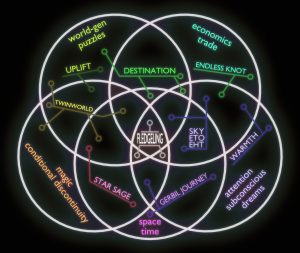
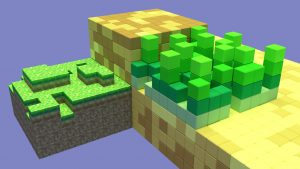

 " src="
" src="